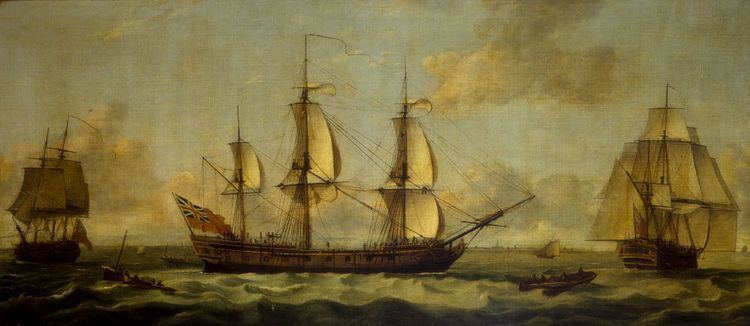Five vessels named Royal Charlotte, for Charlotte of Mecklenburg-Strelitz, consort of King George III, made voyages as East Indiamen for the British East India Company (EIC) between 1762 and 1815:
Royal Charlotte (1761 ship), that Perry, Blackwall, launched her in November 1761; she was of three decks and 771 (or 779 9⁄94) tons burthen (bm). She made three trips to India and the Red Sea for the EIC between February 1762 and July 1770. In 1773 she was sold to the French East India Company.Royal Charlotte (1771 ship), that Dudman, Deptford, launched on 6 December 1771; she was of three decks and 855 72⁄94 tons (bm). She made five voyages to India and China between February 1772 and June 1787; she was present at the Battle of Porto Praya. She was sold in 1787 for breaking up.Royal Charlotte (1789 ship), of 1252 tons (bm), made two trips for the EIC between January 1790 an September 1794. The Admiralty bought her in 1795 and renamed her HMS Malabar. She foundered in 1796.Royal Charlotte (1774) was launched by Bombay Dockyard for Greenway and Co. She made one trip for the EIC, under a Captain William Greenway (or William Logie Smith,) who left Calcutta on 31 January 1796, reached Saint Helena on 8 May, and The Downs on 3 August. There is no record of her making any other trips for the EIC, not even a return voyage. However, on 11 October 1797, Royal Charlotte was anchored off Culpee, an anchorage towards Calcutta, and closer than Saugor. A storm came up and at about 2:24 a.m. a lightning bolt hit her foremast and travelled down to her magazine, where it ignited 500 barrels of gunpowder destined for the Cape of Good Hope. Britannia, which was anchored nearby and which had a like quantity of gunpowder and a similar storage arrangement, observed the disaster; the next day the crew landed their powder to enable the magazine to be more intelligently located. Although Captain Smith of Royal Charlotte and a few of his officers and crew were ashore, the explosion killed 20 European crewmen, 66 lascars, and some 50 women and children who were traveling as passengers. Captain William Logie Smith, who received a letter of marque dated 30 November 1796 for the Royal Charlotte, a ship of 677 tons (bm), 56 men, and 14 x 6-pounder guns. William Logie Smith was in the country service of the EIC when he died in Bengal in March 1803.Royal Charlotte (1796 ship), which Thomas Pitcher, Northfleet, launched on 7 June 1796; she was of 1453 53⁄94 tons (bm), and made eight trips to the Far East for the EIC between August 1796 and August 1815. She was sold for breaking up in 1816. Four captains of this vessel received letters of marque (LoM), as a change in captain required the issue of a new letter. Each of the letters describe the ship as being of 1518 tons (bm), and although this differs from the records in the National Archives, the names of the captains match the records, and one listing of vessels gives the tons burthen as 1252, like that of her predecessor. Over the four letters, crew size rose from 135 to 160 men. Armament changed from forty 18, 12, and 9-pounder guns on the first letter, to thirty-eight 18 & 12-pounders on the subsequent three letters. The captains and the dates of their letters were:William Roper (5 July 1796)Richard Franklin(18 February 1804)Robert Patterson (21 April 1806)Henry Rush (10 February 1809)
